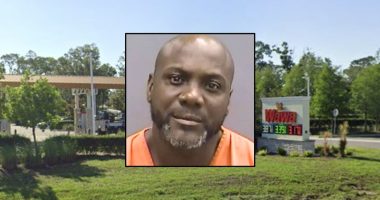
Left: Harry Dunn, former Capitol Police Officer, speaking at the Principles First Summit in Washington, D.C. (Photo by Michael Brochstein/Sipa USA)(Sipa via AP Images). Inset left to right: Brian Mock, Cindy Lou Young in Jan. 6 exhibits from FBI statements of facts (DOJ).
A former U.S. Capitol Police officer and Metropolitan Police officer suing to force the installation of a Jan. 6 memorial for law enforcement, a plaque authorized by Congress in 2022, slammed court filings from two convicted and pardoned rioters who the officers say are seeking to “relitigate the reality” of that fateful day.
Harry Dunn and Daniel Hodges” lawsuit has a straightforward purpose: compelling Architect of the Capitol Thomas Austin to put up the plaque as Congress expressly intended.
Brian Mock and Cindy Lou Young, two of the many Jan. 6 convicts that received pardons from President Donald Trump, have since filed motions to intervene in the case, claiming that their rights are at stake.
In mid-June, Mock and Young — the former convicted for attacking cops and the latter for misdemeanors — asserted that any plaque should be “inclusive” and also “recognize the experiences” of the more than 1,500 Jan. 6 rioters, including those in the crowd who died. For example, Mock and Young argue, Ashli Babbitt — who was shot and killed by a police officer as she climbed through a shattered window inside the Capitol — should be named in the memorial.
While Young said she and others have “endured significant personal, financial, and psychological hardships,” Mock claimed to have a “direct, personal stake in ensuring the accurate historical representation of that day” — his reputation and his constitutional rights.
In an opposition to these motions to intervene, Dunn and Hodges’ lawyers said Tuesday that Mock and Young “have no plausible claim” and that their intervention in the case on equal protection or due process grounds would be a legally baseless sideshow that would only tend to “cause unnecessary delay and prejudice.”
Love true crime? Sign up for our newsletter, The Law&Crime Docket, to get the latest real-life crime stories delivered right to your inbox.
“Mock and Young’s motions are timely, but little else,” the filing said. “To begin with standing, the purported interveners fail to identify any cognizable injury that they have suffered.”
“Unlike the Plaintiffs in this case, Mock and Young were not the intended beneficiaries of this memorial, and so its presence or absence affects them in only the most tenuous ways,” the opposition continued.
Beyond standing, the filing added, Mock and Young are “not a protected class” entitled to enter the lawsuit, let alone for the purpose of relitigating the “reality of January 6” following their convictions and pardons.
That, the officers said, would be a distraction from the main issue: forcing the Capitol architect to “follow the law” and install the plaque that Congress has approved.
“This case is not an opportunity to relitigate the reality of January 6, but rather to compel the Architect of the Capitol to follow the law and install the memorial to the officers that served and sacrificed that day,” the plaintiffs said. “Mock and Young’s motions, and their lack of remorse for their crimes, make clear that they see this case as an opportunity to recast the history of January 6.”
“To allow Mock and Young to intervene would distract from the actual legal matters at hand, and harm the plaintiffs who have already been subject to so many threats from those who attacked the Capitol, and those who supported those attackers,” the filing concluded.
Conrad Hoyt contributed to this report.








